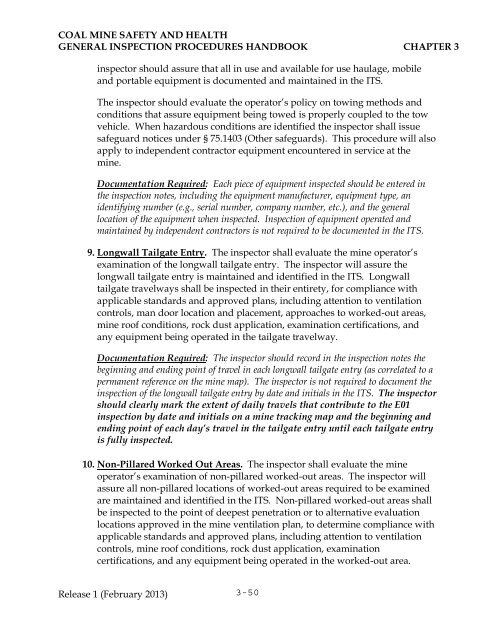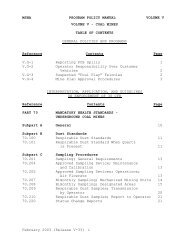MSHA HANDBOOK SERIES - PH13-V-1 - Mine Safety and Health ...
MSHA HANDBOOK SERIES - PH13-V-1 - Mine Safety and Health ...
MSHA HANDBOOK SERIES - PH13-V-1 - Mine Safety and Health ...
You also want an ePaper? Increase the reach of your titles
YUMPU automatically turns print PDFs into web optimized ePapers that Google loves.
COAL MINE SAFETY AND HEALTH<br />
GENERAL INSPECTION PROCEDURES <strong>HANDBOOK</strong> CHAPTER 3<br />
inspector should assure that all in use <strong>and</strong> available for use haulage, mobile<br />
<strong>and</strong> portable equipment is documented <strong>and</strong> maintained in the ITS.<br />
The inspector should evaluate the operator’s policy on towing methods <strong>and</strong><br />
conditions that assure equipment being towed is properly coupled to the tow<br />
vehicle. When hazardous conditions are identified the inspector shall issue<br />
safeguard notices under § 75.1403 (Other safeguards). This procedure will also<br />
apply to independent contractor equipment encountered in service at the<br />
mine.<br />
Documentation Required: Each piece of equipment inspected should be entered in<br />
the inspection notes, including the equipment manufacturer, equipment type, an<br />
identifying number (e.g., serial number, company number, etc.), <strong>and</strong> the general<br />
location of the equipment when inspected. Inspection of equipment operated <strong>and</strong><br />
maintained by independent contractors is not required to be documented in the ITS.<br />
9. Longwall Tailgate Entry. The inspector shall evaluate the mine operator’s<br />
examination of the longwall tailgate entry. The inspector will assure the<br />
longwall tailgate entry is maintained <strong>and</strong> identified in the ITS. Longwall<br />
tailgate travelways shall be inspected in their entirety, for compliance with<br />
applicable st<strong>and</strong>ards <strong>and</strong> approved plans, including attention to ventilation<br />
controls, man door location <strong>and</strong> placement, approaches to worked-out areas,<br />
mine roof conditions, rock dust application, examination certifications, <strong>and</strong><br />
any equipment being operated in the tailgate travelway.<br />
Documentation Required: The inspector should record in the inspection notes the<br />
beginning <strong>and</strong> ending point of travel in each longwall tailgate entry (as correlated to a<br />
permanent reference on the mine map). The inspector is not required to document the<br />
inspection of the longwall tailgate entry by date <strong>and</strong> initials in the ITS. The inspector<br />
should clearly mark the extent of daily travels that contribute to the E01<br />
inspection by date <strong>and</strong> initials on a mine tracking map <strong>and</strong> the beginning <strong>and</strong><br />
ending point of each day’s travel in the tailgate entry until each tailgate entry<br />
is fully inspected.<br />
10. Non-Pillared Worked Out Areas. The inspector shall evaluate the mine<br />
operator’s examination of non-pillared worked-out areas. The inspector will<br />
assure all non-pillared locations of worked-out areas required to be examined<br />
are maintained <strong>and</strong> identified in the ITS. Non-pillared worked-out areas shall<br />
be inspected to the point of deepest penetration or to alternative evaluation<br />
locations approved in the mine ventilation plan, to determine compliance with<br />
applicable st<strong>and</strong>ards <strong>and</strong> approved plans, including attention to ventilation<br />
controls, mine roof conditions, rock dust application, examination<br />
certifications, <strong>and</strong> any equipment being operated in the worked-out area.<br />
Release 1 (February 2013) 3-50
















